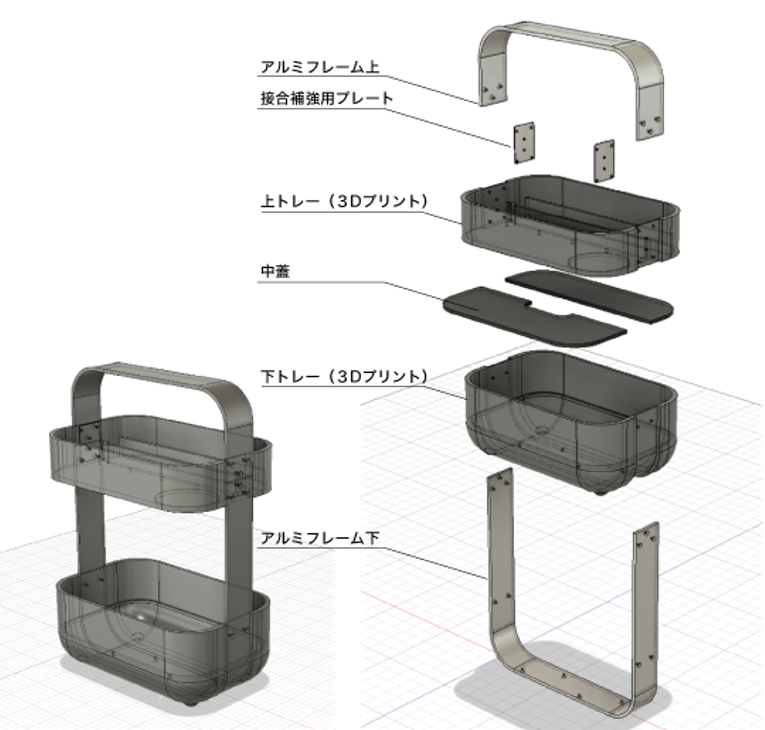ActivityDesign Prototype of a Tool Container for the Portable Health Clinic Service2023.3.16

Research Director:
Associate Professor Naoshige Akita, Faculty of Design
Keywords:
Tele-preventive medicine, healthcare design, product design
The Portable Health Clinic (PHC) is a system that provides remote preventive medicine and health checkup services that has been developed by a research team consisting of Dr. Ashir Ahmed of the Faculty of Information Science and Electrical Engineering, Kyushu University, and Dr. Naoki Nakashima and Dr. Rafiqul Islam Maruf of the Medical Information Center, Kyushu University Hospital, along with the Grameen group of Bangladesh.
In order to provide services to the residents of farming villages in developing countries where adequate medical services do not reach, the PHC system involves health checkup staff carrying an attache case containing various medical checkup equipment and a tablet PC with Internet connectivity via a cellphone to those villages to carry out health checkups. The health data and symptom history of each patient is entered in the tablet PC device to provide health checkup results through analysis using an online database system for disclosure to the patient using the service.
In order to improve the challenging conditions for the health checkup staff, under which they had to carry the attache case containing 5 kilograms of equipment and either walk, ride a bicycle, or drive a motorbike to the farming villages, the above research team proposed a research theme for this project to redesign the container holding that equipment, which we then carried out.
First, in order to understand the usage situation and issues with the existing PHC container, we interviewed Dr. Rafiqul Islam from the research team. From this, we clarified such issues as the difficulty of carrying the existing attaché case when traveling by bicycle or motorbike, and the lack of water-resistance. We also identified the 18 individual needs below from the standpoint of the service operator .
Improvement needs for the existing attache cases
(1) Easy to put in and take out tools
(2) Includes charger
(3) Lightweight
(4) Easy to carry
(5) Easy to operate
(6) Unlikely to forget returning devices
(7) Easy to see at night
(8) Modularized
(9) Wi-Fi capability
(10) Hard to break
(11) Easy to use for women
(12) Waterproof
(13) Heat and cold resistant
(14) Suitable internal temperature
(15) Low cost
(16) Devices arrayed according to frequency of use
(17) Includes medicine case
(18) Holds 20 pamphlets
Then, based on the interview outcome, we selected four design criteria which were particularly important, which were water-resistance, ease of storing and removing the tools, ease of carrying, and appropriate for travel by bicycle or motorbike. The research lab members (Yohei Nishimura, Kaiwen Jiang, Koki Kaji, and Kaisei Kawakubo) then worked on ideas to meet these requirements. From the ideas we came up with, we adopted a proposal combining an existing backpack product with an inner container that would go inside, and produced a prototype (Fig. 1). (Production cooperation: Genki Fujita, Clerical Staff of Education, Graduate School of Design)
The main features of this prototype are as follows. Unlike the attache case, the use of an existing backpack enabled freeing the hands while making the items easy to carry on the back while riding a bicycle or motorbike (Fig. 2). We also used an existing backpack that was highly water-resistant. Meanwhile, for the inner container, we used a configuration with two trays arrayed vertically inside an aluminum frame which serves as the handle (Fig. 3, 4). Our intention was to provide enough strength to adequately protect the contents while enabling stable placement within a narrow space (Fig. 5, 6). Less frequently used items, such as batteries and replacement parts, can be stored in the lower tray under a lid. Furthermore, we eliminated the corners from the bottom of the lower tray, making it easier to place the container in the backpack and giving it a rounded gentle design overall (Fig. 7, 8).
Moving forward, we plan to further redesign the prototype to make it lighter, make the contents easier to see, and lower the cost, and then carry out user evaluations.


This research received a small grant in FY2022 from the Center for Designed Futures of Kyushu University.
